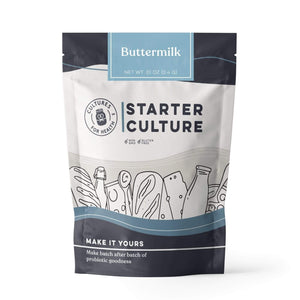
Dry-curd cottage cheese, also known as farmer cheese or baker’s cheese, is the solid portion, or curds, that remain after milk has been cultured and slowly heated. It used to be sold in most supermarkets, but is getting harder to find.
1440 minutes
1500 minutes
2 bowls
INGREDIENTS AND EQUIPMENT AVAILABLE AT CULTURES FOR HEALTH
Buttermilk Starter

Buttermilk Starter
$19.99
This heirloom culture makes batch after batch of traditional cultured buttermilk right on your countertop, easy as pouring milk in a jar. Bake with your buttermilk or add it to cream to make cultured butter.
Dry cottage cheese, also referred to as curd cottage cheese, is a fantastic dairy option for your at-home cheese repertoire. This straightforward dry curd cottage cheese recipe will yield slightly more than 1 1/2 pounds of wholesome cottage cheese curds. One of the great features of dry curd cottage cheese is its ability to freeze well, ensuring a constant supply available for your culinary adventures.
Get our downloadable Cheesemaking Book which provides all the information you need to start making this delicious dry cottage cheese at home to the next level.
ESSENTIAL INGREDIENTS FOR MAKING DRY CURD COTTAGE CHEESE:
- 1 gallon of whole milk, or raw milk with the cream removed
-
1/2 cupcultured buttermilk
INSTRUCTIONS FOR DRY CURD CHEESE RECIPE:
- The first step in making our dry curd cottage cheese recipe is to heat the milk to 75°F in a 6- to 8-quart non-aluminum pan.
- Stir in cultured buttermilk. Cover and keep at 75°F for about 24 hours.
- After 24 hours the milk in the pan will have set to a custard-like consistency and may have a layer of whey on top. At this point cut the curd into 1/2-inch cubes, slicing one direction, then rotating the pan to slice in the opposite direction. Don’t be concerned if your cut lines seem to disappear.Let the curd set for 5 minutes.
- Meanwhile,heat water in a pot large enough to set the 6- to 8-quart pan inside, to about120°F. Alternatively,fill the sink with hot water andplace the pot in the sink.
- Place the pan of curds in the larger pot or sink so that the water level surrounding the pan reaches the level of the curds inside.
- Gently stir the curds for30 seconds every 5 minutes or so as the temperature of the curds slowly rises. Gentle stirring keeps the curds from sticking together (matting).
- When the curds reach100°F, increase the heat under the pot until the curds reach 120°F. If using the sink method,place the pot of milk on a low-heat burner once they have reached100°Fand gently bring the curds up to120°F. Hold the curds at this temperature for25-30 minutes, stirring more vigorously every 5 minutes. Most of the curds will be firm now.Squeeze a few curds to see if they are still soft in the center. (A little soft is OK; runny is not.) If curds are not firm enough, continue to hold at 120°F, checking firmness every 5 minutes.
- Line a colander with a double thickness ofcheesecloth and set it over a container to catch the whey. (Save the whey forother uses, if desired.) Carefullypour the curds into the colander and let drain for 5 minutes.
- Gather up the corners of the cheesecloth andrinse the curds under a stream of very cold water. (Alternatively you could dip the curds in a bowl of cold water.) Rinse until water from curds runs clear. Let the curds hang to finish draining for15 minutes up to an hour.
- Place the curds in a bowl. Add 1 tsp. of salt, if desired. They are now ready to use in a recipe calling for dry curd cottage cheese. Refrigerate and use within a week or wrap tightly and freeze.
One of the great joys of making cottage cheese at home is the level of control you have over the finished product. Whether you prefer large or small curds, a more cream style cottage cheese or a drier variety, the process is very similar. The difference in texture comes from the size of the curds and the amount of whey left in the final product. For a cream style cottage cheese, simply add some cream back into the cheese after it's drained.
Another interesting fact about cottage cheese is its nutritional profile. Cottage cheese is high in protein and calcium, making it a healthy choice for many diets. Whether you're looking to build muscle, lose weight, or simply enjoy a tasty and nutritious snack, cottage cheese is a great option. Plus, when you make it yourself, you know exactly what's going into your food, making it an even healthier option.
Would you like to make your dry cottage cheese at home? Download our Cheesemaking Guide and Recipe Book and start making your dry cottage cheese today!
















